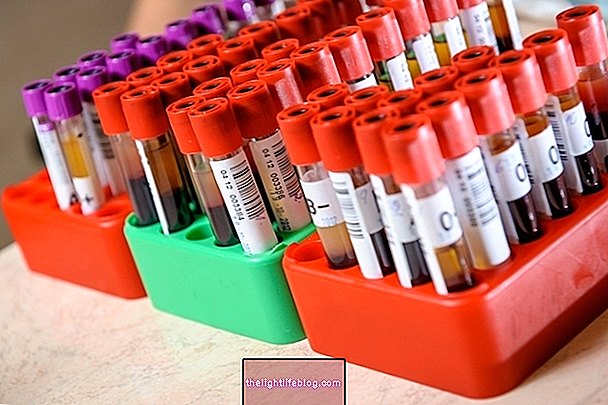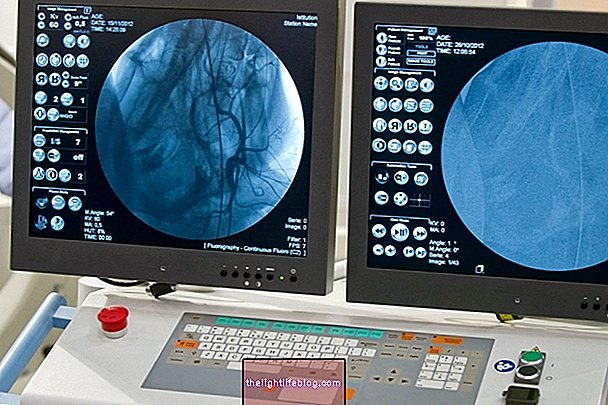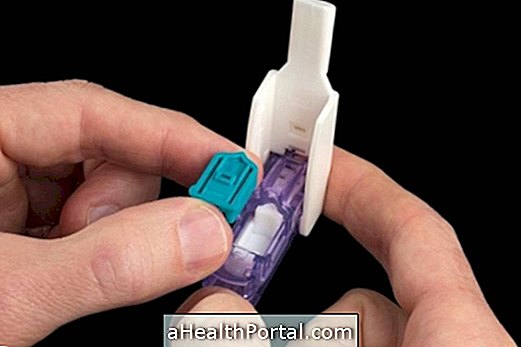Electrophoresis is a laboratory technique performed with the objective of separating molecules according to their size and electrical charge so that the diagnosis of diseases can be made, protein expression can be verified or microorganisms can be identified.
Electrophoresis is a simple and low-cost procedure, being used in laboratory routines and in research projects. According to the purpose of electrophoresis, it may be necessary to carry out other tests and exams in order to reach a diagnosis, for example.

What is it for
Electrophoresis can be performed for several purposes, both in research projects and in diagnosis, since it is a simple and low-cost technique. Thus, electrophoresis can be performed to:
- Identify viruses, fungi, bacteria and parasites, with this application being more common in research projects;
- Paternity test;
- Check the expression of proteins;
- Identify mutations, being useful in the diagnosis of leukemias, for example;
- Analyze the types of circulating hemoglobin, being useful in the diagnosis of sickle cell anemia;
- Assess the amount of proteins present in the blood.
According to the purpose of electrophoresis, it may be necessary to carry out other complementary tests for the doctor to complete the diagnosis.
How it is done
To do the electrophoresis it is necessary the gel, which can be polyacrylamide or agarose depending on the objective, electrophoresis buffer and vat, molecular weight marker and a fluorescent dye, in addition to a UV or LED light equipment, also known as a transilluminator.
After preparing the gel, a specific object must be placed to make the wells in the gel, popularly called the comb, and let the gel set. When the gel is ready, just apply the substances to the wells. For this, a molecular weight marker must be placed in one of the wells, a positive control, which is the substance that is known what it is, a negative control, which guarantees the validity of the reaction, and the samples to be analyzed. All samples must be mixed with a fluorescent dye, as this way it is possible to visualize the bands on the transilluminator.
The gel with the samples must be placed in the electrophoresis vat, which contains the specific buffer solution, and then the device is turned on so that there is electric current and, consequently, potential difference, which is important for the separation of the particles according to their load and size. The electrophoretic running time varies according to the purpose of the procedure, and can last up to 1 hour.
After the determined time, it is possible to view the result of the electrophoretic run through the transilluminator. When the gel is placed under UV or LED light, it is possible to see the banding pattern: the larger the molecule, the less it migrates, getting closer to the well, while the lighter the molecule, the greater the migratory potential .
For the reaction to be validated, it is necessary that the bands of the positive control are visualized and that in the negative control nothing is visualized, because otherwise it is an indication that there was contamination, and the whole process must be repeated.

Types of electrophoresis
Electrophoresis can be performed for different purposes and, according to its purpose, several types of gel can be used, the most common being polyacrylamide and agarose.
Electrophoresis to identify microorganisms is more common to be performed in research laboratories, however, for diagnostic purposes, electrophoresis can be used to identify hematological diseases and diseases that evolve with the increase in the amount of proteins, being the main types of electrophoresis :
1. Hemoglobin electrophoresis
Hemoglobin electrophoresis is a laboratory technique performed to identify the different types of hemoglobin circulating in the blood, making it possible to identify the presence of diseases related to hemoglobin synthesis. The type of hemoglobin is identified by means of electrophoresis at a specific pH, ideally between 8.0 and 9.0, with a pattern of bands being verified that can be compared to the normal pattern, allowing the identification of the presence of abnormal hemoglobins.
What it is done for: Hemoglobin electrophoresis is done to investigate and diagnose diseases related to hemoglobin synthesis, such as sickle cell anemia and hemoglobin C disease, in addition to being useful in differentiating thalassemia. Learn how to interpret hemoglobin electrophoresis.
2. Protein electrophoresis
Protein electrophoresis is an exam requested by the doctor to assess the amount of proteins circulating in the blood and, thus, to identify diseases. This test is done from a blood sample, which is centrifuged to obtain the plasma, which part of the blood, consisting, among other substances, of proteins.
After electrophoresis, a pattern of bands can be visualized and, subsequently, a graph in which the quantity of each fraction of proteins is indicated, being fundamental for the diagnosis.
What it is done for: Protein electrophoresis allows the doctor to investigate the occurrence of multiple myeloma, dehydration, cirrhosis, inflammation, liver disease, pancreatitis, lupus and hypertension according to the band pattern and the graph presented in the examination report .
Understand how it is done and how to understand the result of protein electrophoresis.
Was this information helpful?
Yes No
Your opinion is important! Write here how we can improve our text:
Any questions? Click here to be answered.
Email in which you want to receive a reply:
Check the confirmation email we sent you.
Your name:
Reason for visit:
--- Choose your reason --- DiseaseLive betterHelp another personGain knowledge
Are you a health professional?
NoMedicalPharmaceuticalsNurseNutritionistBiomedicalPhysiotherapistBeauticianOther
Bibliography
- ENCYCLOPEDIA BIOSPHERE, KNOWING SCIENTIFIC CENTER. Electrophoresis: concepts and applications. 2015. Available at:. Accessed on 24 Sep 2019
- KASVI. What is electrophoresis and why is it important?. Available in: . Accessed on 24 Sep 2019
























